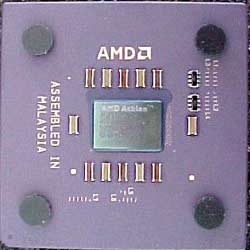Are you tired of toiling near the bottom
of the CPU performance food chain? We are! Let us introduce the 1Ghz Thunderbird
Athlon processor from AMD. The 1GHz Thunderbird Athlon has been widely available in North America for a while now at fairly low prices.
 A quick scan on Pricewatch shows that AMD provides an incredible price advantage over Intel's PIII-1.0GHz counterparts. While an Intel Pentium III 1GHz will burn a hole in your pocket at $435 USD / $657 CDN, an AMD 1Ghz Athlon will only cost you a paltry $171 USD / $258 CDN. A $400CDN difference in price is something to take note of, especially if you're in the market for a new system!
A quick scan on Pricewatch shows that AMD provides an incredible price advantage over Intel's PIII-1.0GHz counterparts. While an Intel Pentium III 1GHz will burn a hole in your pocket at $435 USD / $657 CDN, an AMD 1Ghz Athlon will only cost you a paltry $171 USD / $258 CDN. A $400CDN difference in price is something to take note of, especially if you're in the market for a new system!
This processor is essentially the same as the Athlon
800 that we reviewed here previously, except that it's naturally clocked a lot
higher. Just in case you haven't read that review, or are new to the Thunderbird's, this should bring
you up to speed;
As a quick overview, the Thunderbird series of Athlon CPU's represents AMD's answer to the 1:1 core to cache speed ratio which Pentium III Coppermine have had for quite some time now. I can recall when the Pentium III Katmai (512K cache half speed
cache) CPU's were getting beaten around by the old Slot A Athlons (with 512K
variable speed cache). Intel answered this challenge with their 256KB 1:1 core
to cache speed Pentium III's. Those processors were able to outpace the current Athlons
at the time because of the 256KB of L2 cache.
That cache on those newer Pentium III chips allowed Intel to take the performance lead over the Athlon, at least for a while anyway's. Now
we are at a time when the Pentium III and Athlon are fighting on a more even
ground (in regards to L2 cache speed and size). Unfortunately for Intel and the
Pentium III, the Athlon does have some other obvious advantages (aside from
price).
That fact that the Pentium III only has 32KB of L1 cache and
the Athlon has 128KB, coupled with the fact that the Athlon has a faster and
more advanced floating point unit, utilizes a more bandwidth pleasing 100
Mhz DDR bus equates to lead which has so far proven difficult for
the Pentium III to keep up with. Also, Pentium III's are realistically
topping out at 933Mhz mostly because the 1.0GHz models are still relatively hard
to find. If you can find one, expect to pay significantly more than the AMD
equivalent.
AMD Athlon Processor Overview
The AMD
Athlon processor is among the world's most powerful engines for PC computing,
and represents the industry's first seventh-generation x86 microarchitecture.
The AMD Athlon processor family is designed to power the next generation in x86
computing platforms. It meets the computation-intensive requirements of
cutting-edge software applications running on high-end desktop systems,
workstations, and servers. All AMD Athlon processors are now produced using
0.18-micron process technology.
The AMD Athlon processor provides exceptional processing power on real-world,
mainstream Microsoftr Windowsr compatible software, as well as
computation-intensive applications for high-end desktops. These high-end
workstation applications include digital photo editing, digital video,
commercial 3D modeling, image compression, soft DVD, CAD, and speech recognition
.
Features:
Microarchitecture: The AMD Athlon processor
features a superpipelined, nine-issue superscalar microarchitecture optimized
for high clock frequencies. The AMD Athlon processor contains a total of nine
execution pipelines: three for address calculations, three for integer
calculations, and three for executing x87 (floating point), 3DNow!"! and MMX"!
instructions.
System Bus:The AMD Athlon processor's system bus
is the first> x86 platform bus running at or above 200MHz. At
present, AMD Athlon processors are available with 266MHz and 200MHz system
buses. As one of the fastest x86 processor buses currently available, the design
delivers as high as 100 percent more peak bandwidth than any x86 system bus. It
is designed for scalable multiprocessing and leverages high-performance Alpha"!
EV6 bus technology to enable exceptional system
performance.
Floating Point Engine: The AMD Athlon processor
includes the first fully pipelined, superscalar floating point engine for x86
platforms. The resulting floating point capability is the most powerful ever
delivered in an x86 processor.
Enhanced 3DNow!"! Technology: The AMD Athlon
processor's enhanced 3DNow! technology takes 3D multimedia performance to
incredible heights and builds on the 21 instructions of AMD's original 3DNow!
technology-the first x86 instruction set to use superscalar SIMD floating point
techniques. Enhanced 3DNow! technology adds 24 instructions-19 to improve MMX
integer math calculations and enhance data movement for Internet streaming
applications and 5 DSP extensions for soft modem, soft ADSL, Dolby Digital, and
MP3 applications.
Cache Architecture: The AMD Athlon processor
boasts a 384K total full-speed on-chip system cache including 128K L1
cache--four times that of Intel's Pentiumr III processor--and 256K on-chip
full-speed L2 cache. This performance-enhancing cache design helps boost overall
system performance. |
All of the background information is interesting, but benchmarks are more useful, and
much more fun!!

